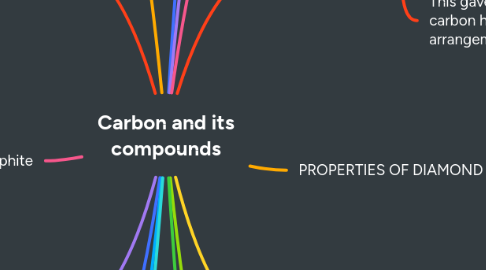Carbon and its compounds
por Aditi Gupta


1. uses of diamond
1.1. They are used in the production of jewellery such as rings, earrings.
1.2. Diamonds are used for industrial purposes.
2. GRAPHITE
2.1. This allotrope of carbon is composed of flat, 2 dimensional carbon atoms which are arranged hexagonally
2.2. In each layer, each carbon atom is linked to 3 carbon atoms via c-c covalent bond. Are you?
3. properties of graphite
3.1. Since the layers of this allotrope are stacked over each other this can act as a lubricant.
3.2. It also has a metallic luster which helps in the conduction of electricity. It is a very good conductor of both heat and electricity.
4. uses of graphite
4.1. Used in making a pencil. Used as a dry lubricant. For making electrodes. For polishing iron articles.
5. BUCKMINISTER FULLERENE
5.1. It is designed by the US scientist Buckminster Fuller. The first one to be identified was C-60 which has carbon atoms arranged in the form of football.
6. TETRAVALENCY
6.1. Carbon can neither lose nor gain electrons to attains octet. Thus, share the four electrons with atoms. This characteristics of carbon by virtue of which it forms 4 covalent bonds called Tetra valency of carbon.
7. Hydrocarbons
7.1. The compounds, which are entirely made up of Hydrogen and carbon are called hydrocarbons.
8. characteristicsof covalent compounds
8.1. Covalent compounds exist as gases, liquids, or soft solids.
8.1.1. Covalent compounds are insoluble, in water, but they dissolve in organic compounds.
8.1.1.1. The melting and boiling points of covalent compounds are generally low.
8.1.1.1.1. Covalent compounds are formed on the basis of sharing electrons. When the electrons are shared within the bonds, there are no electrons available to conduct electricity. Hence, they are poor conductors of electricity.
9. Carbon
9.1. free state
9.1.1. combined state
9.1.2. Carbon formed covalent compounds by sharing the electrons.
9.2. Carbon is mainly formed in three forms. For example, diamond, graphite, and coal
10. Allotropes of carbon
10.1. An element possessing different physical form of existence is known as allotrope of that element.
11. DIAMOND
11.1. It has a number of carbons linked together tetrahedrally.Each tetrahedral unit consists of carbon bonded with 4 carbon atoms which in turn bonded with other carbons
11.2. This gave rise to an allotrope of carbon having a three-dimensional arrangement of carbon atoms.
12. PROPERTIES OF DIAMOND
12.1. It is extremely hard.
12.2. It is a bad conductor of electricity.
12.3. It is a good conductor of heat.
12.4. It has very high melting point.
13. CATENATION
13.1. Carbon has the unique ability to form bonds with other atoms of carbon, giving rise to large molecules. This property is called catenation.
14. vital force theory
14.1. It is a theory made by scientist berzelius in 1809which assumed that organic compounds only formed in living cells and it is impossible to prepare them in laboratories
14.2. friedrich wohler disproved this in1828 by preparing urea from nh4cno(ammonium cyannate)
14.3. Carbon compounds except for. Oxides of carbon,carbonate and hydrogencarbonate salts continue to study under organic chemistry.
15. types of hydrocarbons
15.1. unsatutrated for eg ethene,propene,butene
15.1.1. satutrated
15.1.1.1. examples: methane,ethane
15.1.2. alkanes
